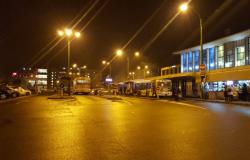INS published Friday the job vacancies: about 39,900, with an average of 449,000 unemployed. That means 11.25 unemployed for one unfilled job. Hundreds of thousands of people complain that they can’t find work and tens of thousands of companies say they can’t find employees.
Workers on the construction sitePhoto: Inquam Photos / George Călin
Labor demand and supply are completely decoupled in Romania; more and more graduates will be faced with jobs that will not match their training
Demand and supply of labor are decoupled in Romania; more and more graduates will be faced with jobs that will not match their training, according to a report recently published by Cedefop – the European Center for the Development of Vocational Training.
Despite the growing supply of college-educated workers, there will be difficulties in filling these jobs, and these difficulties will cause workers with college degrees to be offered lower-level non-college-demanding jobs than the qualifications they hold.
The bad part is that the job is not necessarily in the area where the unemployed live, nor do the qualifications required for the job vacancy correspond to the training of those looking for work.
That’s right, for about two million Romanians, distance is not an obstacle, so they accept to commute.
About a third of them work in a county other than the one where they live, and two thirds in a different locality from the county where they live.
In Ilfov, commuters represent almost 50% of all workers, most likely coming to work in the Capital. Dâmbovița county follows, where commuters represent over 44% of the employed population, according to Statistics. Giurgiu and Ialomita are the next “pools” of commuters.
The case of Mr. Ionescu
Mr. Ionescu is one of hundreds of thousands of unemployed. He worked as a bank clerk until the institution let him go. Ionescu worked in a small provincial town, where everyone knows everyone. There are job vacancies in that town, but Mr. Ionescu refuses positions that he considers below his dignity. “From 6,000 lei a month, I can’t hire myself as a seller in a boutique with 2,000 lei a month,” he says. It is understandable.
Ionescu is trying to find a job also in the financial area and has contacted other banks in the city to offer his services. For now he waits. It is waiting unemployment.
The case of Mr. Popescu
Mr. Popescu worked in marketing. Sales, more precisely. He was selling the products of a curtain and bed linen factory. That’s what he’s done for a living, that’s what he’s good at. The business didn’t work anymore so he stayed on the road. There would be another similar factory that is about 200 kilometers away and where he could get a job, but how could he leave his wife and children to move practically 200 kilometers from home? His job application will not meet the job offer any time soon. And the country is full of Popești and Ionești.
The case of Mr. Constantinescu
Former top corporatist, with a salary of thousands of euros for many years. He has seen half the world. A young man (hired by him some time ago) came and blew his job. Now he lives on what he collected during the years of leadership. He has not worked for 3 years and does not want to drop below a certain salary level. Wait “until something comes for me”, he says sadly. That something will not come in a hurry, because the world has changed.
The fact that he is no longer invited to the parties where he was once considered the soul of the party affects him the most.
The case of Mr. Nițescu
Family, two children. Each spouse works abroad, 6-9 months a year. I take about 1000 eur/net/monthly. With the money collected THERE they enlarge their household HERE. There he works illegally. He in carpentry, she in the social field.
They are not registered as unemployed, nor are they listed as employed, because they are not. They don’t want to settle there (with some efforts they could) because “you better take her here, with THEIR money”. But he wouldn’t grow old here either because only a blind man wouldn’t see where the country is going.
“For now, we’re not complaining, we’ll see what’s going to happen,” they say in unison at a barbecue offered to the neighbors. The next day they were going to go abroad again, because they had run out of money.
The over-65 working population in 2035 will triple in number compared to the 65+ working now
The population aged over 65 who will be working in 2035 will triple in number compared to those 65+ who are working now, Prof. Dr. Cătălin Ghinăraru explained in a discussion with HotNews, based on Cedefop data, one of the decentralized agencies of the European Union that periodically makes projections on the labor market. As a share of the population, seniors will exceed the 30% threshold, confirming the country’s severe aging process.
30 years ago, their share barely reached 13%, says the Romanian researcher, the expert whom the European Commission calls when discussing the labor market in Romania.
“The good part is that the employed population is growing and will increase by about 1% per year, which means an annual increase above the EU-27 average”, explains Ghinăraru. The researcher estimated 30 years ago that we will have to face the challenge called “multicultural Romania”, along with the filling of vacant positions with immigrants brought from outside the country.
Nea Vasile manages a small vineyard near Pietroasele-Buzău. This year he had no one to pick the grapes with, although he offered each picker food, drink, cigarettes plus 150 lei net/day. He had vacancies, as the statisticians would say. The locals were simply not interested, so nea Vasile had to buy a grape picking machine, so as not to be left with unpicked grapes. In total, in Romania this autumn there were around 40,000 unfilled jobs or, better said, uninteresting for the locals.
Romania’s population will decrease by 9% in the period 2020-35. EU predicts ‘precipitous’ decline in 15-54 population and rise in 65 and over population
The changes in the labor force in Romania in the next 10 years will be determined by the aging of the population and the increasing participation rates in most age groups.
The total labor force in Romania will increase by 6% in the period 2020-35, compared to the decrease by 6% in the last 15 years, according to Cedefop data, consulted by HotNews.
Also, the total participation rate in Romania will increase by 9 pp in the period 2020-35, compared to an increase of only 1 pp for the EU-27. This in the conditions where the total population will decrease by 9% in the period 2020-35, as in the interval 2005-2020 it decreased by 8%.
There will also be problems in the area of Education, because the EU agency that made the forecast estimates a “precipitous” decrease in the population aged 15-54 in Romania, while the population aged 55-59 and 65 and over will grow strong.
The participation rates of all age groups over 20 in Romania will increase strongly in the next 10 years, but the strongest growth is projected for the 60-64 age group (34 pp).
Likewise, labor market participation rates will increase for women by 11 percentage points, and for men by 7 percentage points in the period 2020-2035.
Forecasts speak of 4.7 million jobs to be filled, of which 700 thousand new jobs and 4 million vacant jobs as a result of resignations/retirements
Employment growth in the manufacturing industry will be relatively fast, with dynamics of more than 2% per year in the period 2022-30.
On the other hand, employment in the primary and utilities sector, which represents about a quarter of employment in Romania, mainly in agriculture, is estimated to decrease by 5% per year during the same period. The administrative and support services sub-sector is forecast to experience a decline in employment of 0.8% per year over the period 2022-30.
In distribution and transport, employment in the major sub-sectors of wholesale and retail trade (15% of employment), land transport (5% of employment) and accommodation and food (3% of employment work) will grow strongly in the period 2022-2030, Cedefop data show.
The same will happen in the production of cars, food, beverages and tobacco, while employment in textiles & leather is forecast to fall sharply.
The number of available jobs shows the number of vacancies as a result of newly created jobs and those left vacant as a result of the departure (by resignation or retirement) of those who occupied them.
Most occupations, with the exception of agricultural and fishing workers, will see job growth.
Forecasts speak of 4.7 million jobs to be filled, of which 706,000 new jobs and 4 million jobs become vacant as a result of employee resignations/retirements.
In the industry, the jobs of executive directors, senior officials and managers will decrease and some middle-level occupations will increase: assemblers, clerks, and sales jobs.

In the industry, the jobs of executive directors, senior officials and managers will decrease and some middle-level occupations will increase: assemblers, clerks, and sales jobs.
Also, occupations that do not require high skills will increase, with the exception of workers in mining, construction and transportation.
The share of skilled workers will also grow somewhat more slowly, from 23% in 2022 to 27% in 2035.
The market share of medium-skilled workers will also increase slightly from 61% in 2022 to 65% in 2035. Compared to the EU-27 average, Romania is doing poorly in terms of high-skilled and above-average jobs with medium skills.
Tags: ANALYSIS Great Resignation Great Mismatch Statistics published number jobs employers unable find people
-







